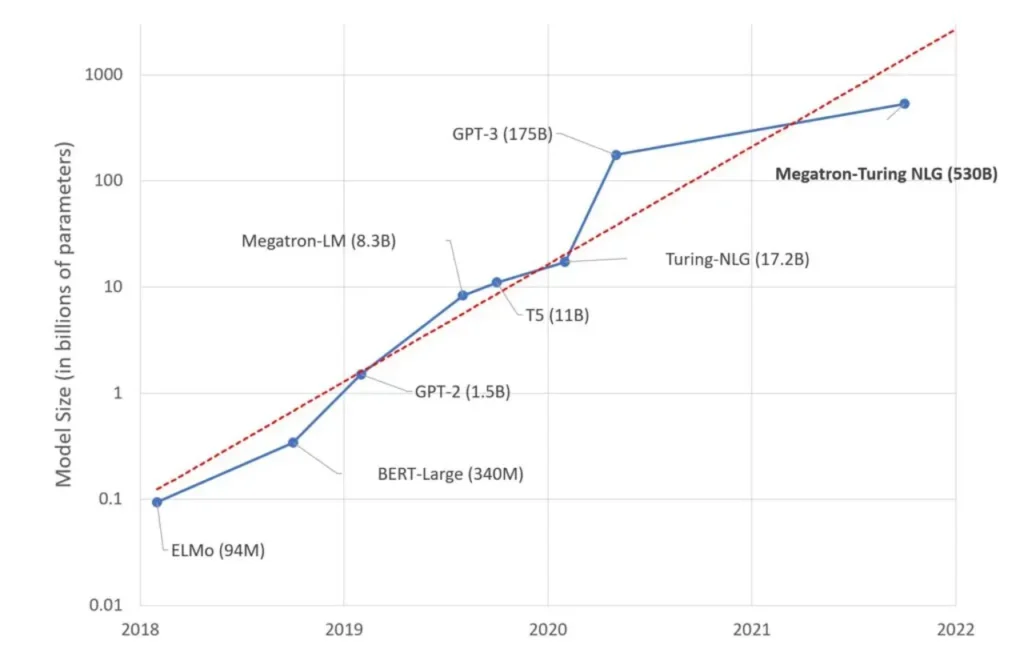Microsoft’s Unveils MAI-1 AI model with 500 billion parameters is poised to revolutionize the tech industry and compete with giants like Google and OpenAI.
Introduction: Microsoft Unveils MAI-1
The world of artificial intelligence (AI) is heating up with a race for larger and more powerful language models. Google and OpenAI are already in the spotlight with their impressive models, but what about Microsoft? The tech giant has been quietly making significant strides in AI development. Recent reports suggest Microsoft might be working on a groundbreaking 500-billion parameter language model – let’s dive in!
What Are Large Language Models (LLMs)?
Before we dig into Microsoft’s potential AI powerhouse, let’s make sure we’re on the same page about what LLMs are.
- LLMs in Plain English: Imagine an incredibly smart autocomplete feature, but on a massive scale. LLMs are AI models trained on gigantic amounts of text data. They can generate realistic human-like text, translate languages, write different kinds of creative content, and answer your questions in an informative way.
Why the Hype around LLMs?
- The Power of Scale: Large language models get increasingly better with more parameters (essentially, the ‘variables’ the model uses to understand patterns). It’s like adding more neurons to a brain; it translates to surprising new abilities.
- Versatility: LLMs can be fine-tuned for specific tasks, making them helpful across various industries. Think of them as the ‘Swiss Army knives’ of AI.
Microsoft’s AI Trajectory
- Not Starting From Scratch: Microsoft has a rich history in AI development. They’ve created models like Turing NLG and are heavily invested in OpenAI (the company behind ChatGPT and others).
- The Power of Azure: Microsoft’s cloud platform, Azure, provides the massive computing power needed to train giant LLMs. It’s a big advantage in this field.
What is MAI-1?
Overview of Microsoft’s MAI-1 Model
MAI-1, or Microsoft AI-1, is Microsoft’s latest large language model (LLM) designed to handle complex language tasks with unprecedented efficiency and accuracy. With 500 billion parameters, MAI-1 is Microsoft’s largest model to date and is expected to compete directly with other high-parameter models like OpenAI’s GPT-4 and Google’s Gemini Ultra.
Technical Specifications and Capabilities
The MAI-1 model utilizes advanced neural network architectures and has been trained on a diverse dataset comprising web text, books, and other publicly available text sources. This extensive training allows MAI-1 to perform a variety of tasks, from natural language processing to more complex reasoning and decision-making processes.
Potential Applications of MAI-1
Enhancing Microsoft’s Bing and Azure
One of the primary applications of MAI-1 is expected to be in enhancing Microsoft’s own services, such as Bing search engine and Azure cloud services. By integrating MAI-1, Microsoft aims to improve the accuracy and responsiveness of Bing’s search results and provide more sophisticated AI solutions through Azure.
Revolutionizing Consumer Applications
Beyond Microsoft’s own ecosystem, MAI-1 has the potential to revolutionize consumer applications. This includes real-time language translation, advanced virtual assistants, and personalized content recommendations, which could significantly enhance user experience across various platforms.

Comparison with Other AI Models
MAI-1 vs. GPT-4
While OpenAI’s GPT-4 has double the parameters of MAI-1, the latter’s design focuses on efficient data processing and potentially faster inference times, which could offer competitive advantages in specific applications.
Innovations Over Google’s Gemini Ultra
Google’s Gemini Ultra boasts 1.6 trillion parameters, yet MAI-1’s architecture is designed to be more adaptable and potentially more efficient in handling real-world tasks, emphasizing practical application over sheer parameter count.
The 500-Billion Parameter Rumor: What Do We Know?
While not officially confirmed, reports suggest Microsoft is indeed working on a 500-billion parameter LLM, potentially named MAI-1. Here’s what the buzz suggests:
- Chasing the Big Players: This model would put Microsoft in direct competition with the likes of Google and OpenAI in the race for AI dominance.
- Power and Cost: A 500-billion parameter model promises increased capabilities, but it also comes with immense training costs and technological complexity.

What Could a 500-Billion Parameter Model Do for Microsoft?
- Bing Boost: Microsoft could integrate a powerful LLM into its search engine, potentially enhancing Bing’s ability to understand complex queries and provide more informative results.
- Enhanced Office Tools: Imagine supercharged AI assistance in your everyday Microsoft Office apps, helping you write better emails, presentations, and more.
- The Future of AI Products: This model could be a building block for future AI-powered products and features we haven’t even imagined yet.
Challenges and Considerations
- Computing Power and Cost: Training and running such a large model is very resource-intensive.
- Data Bias: LLMs are only as good as the data they’re trained on. Careful data curation is crucial to avoid harmful biases.
What is the significance of the 500 billion parameters in mai-1?
The significance of the 500 billion parameters in Microsoft’s MAI-1 AI model lies in its potential to handle complex language tasks with high efficiency and accuracy. Parameters in an AI model are essentially the aspects of the model that are learned from the training data and determine the model’s behavior. More parameters generally allow for a more nuanced understanding of language, enabling the model to generate more accurate and contextually appropriate responses.
In the context of MAI-1, the 500 billion parameters place it as a significant contender in the field of large language models (LLMs), positioning it between OpenAI’s GPT-3, which has 175 billion parameters, and GPT-4, which reportedly has around one trillion parameters. This makes MAI-1 a “midrange” option in terms of size, yet still capable of competing with the most advanced models due to its substantial parameter count.
The large number of parameters in MAI-1 suggests that it can potentially offer detailed and nuanced language processing capabilities, which are crucial for tasks such as natural language understanding, conversation, and text generation. This capability is expected to enhance Microsoft’s products and services, such as Bing and Azure, by integrating advanced AI-driven features that improve user experience and operational efficiency.
Furthermore, the development of MAI-1 with such a high number of parameters underscores Microsoft’s commitment to advancing its position in the AI landscape, directly competing with other tech giants like Google and OpenAI. This move is part of a broader trend where leading tech companies are increasingly investing in developing proprietary AI technologies that can offer unique advantages and drive innovation within their ecosystems.
How does mai-1 compare to other ai models in terms of parameters?
GPT-3
Large language model
| Developer | OpenAI |
| Release Date | June 11, 2020 (beta) |
| Key Features | Uses a 2048-token-long context, 16-bit precision, and has 175 billion parameters. |
MAI-1, Microsoft’s newly developed AI model, is reported to have approximately 500 billion parameters. This places it in a unique position within the landscape of large language models (LLMs) in terms of size and potential capabilities. Here’s how MAI-1 compares to other notable AI models based on their parameter counts:
- GPT-3: Developed by OpenAI, GPT-3 has 175 billion parameters. MAI-1, with its 500 billion parameters, significantly surpasses GPT-3, suggesting a potential for more complex understanding and generation of language.
- GPT-4: Although the exact parameter count of GPT-4 is not explicitly mentioned in the provided sources, it is rumored to have more than 1 trillion parameters. This places GPT-4 ahead of MAI-1 in terms of size, potentially allowing for even more sophisticated language processing capabilities.
- Gemini Ultra: Google’s Gemini Ultra is reported to have 1.56 trillion parameters, making it one of the largest models mentioned, surpassing both MAI-1 and GPT-4 in terms of parameter count. Another source mentions Gemini Ultra having 540 billion parameters, which still places it ahead of MAI-1 in terms of size.
- Other Models: Other models mentioned include smaller open-source models released by firms like Meta Platforms and Mistral, with around 70 billion parameters, and Google’s Gemini, with versions ranging from 10 trillion to 175 trillion parameters depending on the specific model variant.
The parameter count of an AI model is a crucial factor that can influence its ability to process and generate language, as it reflects the model’s complexity and potential for learning from vast amounts of data. However, it’s important to note that while a higher parameter count can indicate more sophisticated capabilities, it is not the sole determinant of a model’s effectiveness or efficiency. Other factors, such as the quality of the training data, the model’s architecture, and how it’s been fine-tuned for specific tasks, also play significant roles in determining its overall performance and utility.In summary, MAI-1’s 500 billion parameters place it among the larger models currently known, suggesting significant capabilities for language processing and generation. However, it is surpassed in size by models like GPT-4 and Gemini Ultra, indicating a highly competitive and rapidly evolving landscape in the development of large language models.
What are the potential applications of mai-1?
The potential applications of Microsoft’s MAI-1 AI model are vast and varied, reflecting its advanced capabilities due to its large scale of 500 billion parameters. Here are some of the key applications as suggested by the sources:
- Enhancement of Microsoft’s Own Services:
- Bing Search Engine: MAI-1 could significantly improve the accuracy and efficiency of Bing’s search results, providing more relevant and contextually appropriate responses to user queries.
- Azure Cloud Services: Integration of MAI-1 into Azure could enhance Microsoft’s cloud offerings by providing more sophisticated AI tools and capabilities, which could be used for a variety of cloud-based applications and services.
- Consumer Applications:
- Real-Time Language Translation: MAI-1’s advanced language processing capabilities could be utilized to offer real-time translation services, making communication across different languages smoother and more accurate.
- Virtual Assistants: The model could be used to power more responsive and understanding virtual assistants, improving user interaction with technology through more natural and intuitive conversational capabilities.
- Personalized Content Recommendations: MAI-1 could be used to tailor content recommendations more accurately to individual users’ preferences and behaviors, enhancing user experiences across digital platforms.
- Professional and Academic Applications:
- Academic Research: MAI-1 could assist in processing and analyzing large sets of academic data, providing insights and aiding in complex research tasks.
- Professional Tools: Integration into professional tools such as data analysis software, project management tools, or customer relationship management systems could be enhanced by MAI-1, providing more intelligent and adaptive functionalities.
- Development of New AI-Driven Products:
- Generative Tasks: Given its scale, MAI-1 could be adept at generative tasks such as writing, coding, or creating artistic content, potentially leading to the development of new tools that can assist users in creative processes.
- Enhanced User Interaction:
- Interactive Applications: MAI-1 could be used to develop more interactive applications that can understand and respond to user inputs in a more human-like manner, improving the overall user experience1.
The development and integration of MAI-1 into these applications not only highlight its versatility but also Microsoft’s strategic focus on enhancing its technological offerings and competitive edge in the AI market. As MAI-1 is rolled out and integrated, its full range of applications and capabilities will likely become even more apparent, potentially setting new standards in AI-driven solutions.
Conclusion: Microsoft Unveils MAI-1
Microsoft building a 500-billion parameter LLM could be a game-changer, signaling increased AI investment from the tech giant. While challenges exist, the potential benefits are tremendous. If the rumors prove true, it will be exciting to see how Microsoft puts this potential AI superstar to work.
